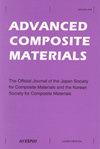纤维各向异性对碳纤维增强热塑性塑料拉伸弹性模量估算的影响
IF 2.3
3区 材料科学
Q3 MATERIALS SCIENCE, COMPOSITES
引用次数: 0
摘要
采用两种微观力学模型研究了各向异性纤维性能对碳纤维增强聚酰胺6(CFRPA6)弹性模量估算的影响;Nairn等人和Hashin(N–H)模型,以及Mori–Tanaka(M–T)模型。首先,通过与CFRPA6的注射成型哑铃试样测得的弹性模量进行比较,验证了这些模型的准确性。尽管从N–H模型和M–T模型估计的弹性模量之间存在细微差异,但从模型特性的角度讨论了差异。接下来,在几种条件下计算了假设碳纤维(CF)为各向同性所引起的估计误差。最大误差出现在拉伸方向垂直于纤维轴的条件下。尽管CF具有较大的各向异性,但两种模型的各向异性都约为10%。我们推断这个小误差是由特定的应力场引起的。本文章由计算机程序翻译,如有差异,请以英文原文为准。
Influence of anisotropic fiber properties on tensile elastic modulus estimation for carbon fiber reinforced thermoplastics
The influence of anisotropic fiber properties on estimation of the elastic modulus of carbon fiber-reinforced polyamide 6 (CFRPA6) was studied using two kinds of micromechanics models; Nairn et al. and Hashin (N–H) models, and Mori–Tanaka (M–T) model. First, these models’ accuracy was verified by comparison with an elastic modulus measured for injection molded dumbbell specimens of CFRPA6. Although there was a slight difference between the elastic moduli estimated from the N–H models and the M–T model, the difference was discussed in terms of model properties. Next, estimation errors caused by assuming carbon fiber (CF) as isotropic were calculated under several conditions. The maximum error occurred in the condition that the tensile direction was perpendicular to the fiber axis. Despite CF had large anisotropy, it was approximately 10% for both models. We infer that the small error was caused by a specific stress field.
求助全文
通过发布文献求助,成功后即可免费获取论文全文。
去求助
来源期刊

Advanced Composite Materials
工程技术-材料科学:复合
CiteScore
5.00
自引率
20.70%
发文量
54
审稿时长
3 months
期刊介绍:
"Advanced Composite Materials (ACM), a bi-monthly publication of the Japan Society for Composite Materials and the Korean Society for Composite Materials, provides an international forum for researchers, manufacturers and designers who are working in the field of composite materials and their structures. Issues contain articles on all aspects of current scientific and technological progress in this interdisciplinary field. The topics of interest are physical, chemical, mechanical and other properties of advanced composites as well as their constituent materials; experimental and theoretical studies relating microscopic to macroscopic behavior; testing and evaluation with emphasis on environmental effects and reliability; novel techniques of fabricating various types of composites and of forming structural components utilizing these materials; design and analysis for specific applications.
Advanced Composite Materials publishes refereed original research papers, review papers, technical papers and short notes as well as some translated papers originally published in the Journal of the Japan Society for Composite Materials. Issues also contain news items such as information on new materials and their processing."
 求助内容:
求助内容: 应助结果提醒方式:
应助结果提醒方式:


